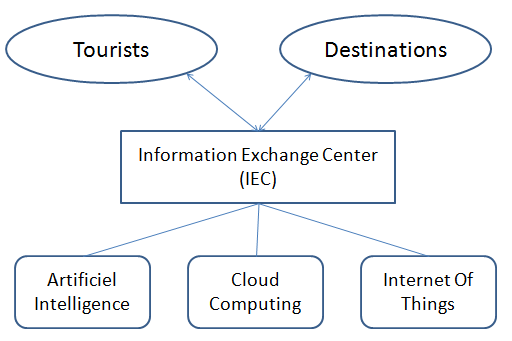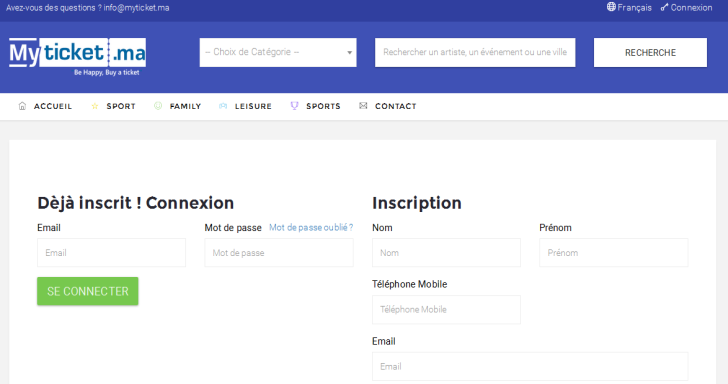-
Paper Information
- Paper Submission
-
Journal Information
- About This Journal
- Editorial Board
- Current Issue
- Archive
- Author Guidelines
- Contact Us
Advances in Computing
p-ISSN: 2163-2944 e-ISSN: 2163-2979
2017; 7(1): 11-14
doi:10.5923/j.ac.20170701.02

Design of Electronic Ticket System for Smart Tourism
1Groupe Signaux Aléatoires, Réseaux et Systèmes, Ecole Nationale des Sciences Appliquées de Safi (ENSAS), Université Cadi Ayyad, Marrakesh, Morocco
2Groupe Matériaux et Instrumentations, Département Génie Electrique, Ecole Supérieure de Technologie (ESTM), Université Moulay Ismail, Meknes, Morocco
Correspondence to: Anouar Dalli, Groupe Signaux Aléatoires, Réseaux et Systèmes, Ecole Nationale des Sciences Appliquées de Safi (ENSAS), Université Cadi Ayyad, Marrakesh, Morocco.
| Email: |  |
Copyright © 2017 Scientific & Academic Publishing. All Rights Reserved.
This work is licensed under the Creative Commons Attribution International License (CC BY).
http://creativecommons.org/licenses/by/4.0/

Tourism is one of the most benefitted areas of internet and its related progressive technologies. Smart tourism requires bringing together the various stakeholders in the tourism industry through a common platform of technology. This paper aims to provide an insight into this concept, we firstly introduce the technological foundation of smart tourism system, and then we propose an electronic ticketing system that can be is proposed to integrate the information of events that could interest tourist. The benefits and challenges which may occur or have occurred in the implementation of smart tourism are finally discussed.
Keywords: Smart tourism, Internet of things, Smart cities, Cloud computing
Cite this paper: Anouar Dalli, Seddik Bri, Design of Electronic Ticket System for Smart Tourism, Advances in Computing, Vol. 7 No. 1, 2017, pp. 11-14. doi: 10.5923/j.ac.20170701.02.
Article Outline
1. Introduction
- These days, it has become easier to book a holiday online. Likewise, it is very convenient for the hotels and airlines to operate their business online as it has a wider approach. Internet has radically changed the conventional business models and people are widely adapting to it.The concept of “Smart tourism” is inherited from “smart city”, it is defined as a platform which integrates tourism sources and information technologies, such as Artificial Intelligence, cloud computing and Internet of things to provide explicit information and efficient services to tourists in certain cities based on the development of innovative mobile technology [1]. Smart tourism is based on Internet of Things (IoT) where any device or object can be made smart and identifiable through radio frequency tags. These devices can communicate with many other smart devices through the network. The communication generates a large amount of data that can be stored and computed on the available Cloud services. Tools of Big Data analysis can be very useful in analyzing the trends and patterns in the data. The use of these technologies will help both the tourism industry as well as the tourists [2]. In this work, Section II introduces the technological foundation of smart tourism and describes the main process and design of this model. Section III presents a case study of system of ticketing that could be introduced as a contribution for smart tourim, the system presented in this paper is evaluated in Section IV. Finally, Section V draws a conclusion.
2. Technological Foundation of Smart Tourism
2.1. Concept of Smart Tourism
- Smart tourism destination can be defined as the following: “a platform, which is implementing information and communication technologies (ICT) such as Artificial Intelligence, Cloud Computing and Internet of Things to offer the tourist personalized information and enhanced services established by mobile end-user devices” [3].The smart tourism experience is rich and efficient in meaning. Visitors are active vigorous participants in the creation of smart tourism by not only consuming the service but also create, annotate or otherwise enhance the information that constitutes the basis of the experiences for instance hastaging or uploading the pictures taken on social media etc. There are many ways to perform smartness as a tourism destination. Referring to the technological aspect smartness is also shown by the implementation of tourism related applications that can be used within Smart Cities components.
2.2. Structure of Smart Tourism
- The various technologies which interplay to provide Smart Tourism services will be the web, mobile, cloud computing, Internet of Things (IoT) and Big Data analysis. Simple devices like our mobile phones are equipped with camera, microphone, sensors to detect movements etc. The information collected by such smart phones can be processed on servers and hence used for smart living. Smart living requires smart houses and smart work conditions. That means all the services used for living like healthcare; education, tourism etc should turn smart as well [1-4].A smart tourism system includes these elements: information exchange center (IEC), tourists, Destinations. The figure 1 shows the structure of smart tourism [3].
 | Figure 1. Structure of smart tourim |
2.3. Applications of Smart Tourism
- Smart Tourism will result as an amalgamation of the existing online business model with the modern Information and Communication Technology (ICT). Then the concept of smart tourism can summarized about these applications:Ÿ Use of sensors, cameras and smart phones: The objects of interest of cities will be the tourist destinations like cultural places. Such destinations can be equipped with sensors, cameras and other smart devices like Touch screens which can collect data about tourists visiting those places [2].Ÿ Use of Cloud services and Internet of Things (IoT): Such vast amount of data can then be stored on Cloud servers using the wireless or wired network. This data can then be analyzed and put to efficient use by the various stakeholders in the tourism sector. Ÿ Better assistance to tourists through mobile tours and apps: Virtual tours are provided to the tourists on their mobile phones as well as touch screens installed at various locations [5]. Ÿ Collaboration of web and mobile services: The initial bookings may be done through websites but the actual experience of touring a place will all be managed by the smart coordination of the objects at that place which will enhance the overall experience of the tourist.
3. Case Study
3.1. Electronic Ticket for Smart Tourism (ETST)
- The concept of ETST is showed in table 1. The ETST can be used for events, accommodation and shopping. Tourists can use their smart phone to buy electronic tickets of the destinations or to events [6, 7].
|
 | Figure 2. The architecture of ETST |
3.2. Prototype
- This section presents a case study for Myticket.ma, in this website tourists can choose their interested ticket, and the ticket package can be bound with the ticket certificates and end user application in their smart phone. Tourists can carry their smart phone to get tourism services conveniently during travels. Service providers (hotel, monuments, restaurants…) can provide the information of their products and services, and travel agencies can design the content of ticket package. Tourists can use end user application in smart phone to set their budgets and interested tickets to get the customized and recommended ticket package. Then tourists can choose their interested tourism services and bind the electronic ticket package with end user application in their smart phone. Service providers can use smart phone or tablet personal computer (PC) to verify the tourist’s certificates and provide tourism services.In planning to implement the proposed system, the following screenshots are expected. The ticket registration page is shown in Figure 3.
 | Figure 3. A Screenshot of Registration Page |
 | Figure 4. Screenshot of an event |
4. Discussion
4.1. Advantage
- The e-ticket concept is attractive for both customers and service providers. From a customer view, it provides the following advantages:Ÿ Faster and more convenient verification of a ticket;Ÿ The ability to profit from a flexible fare pricing scheme (with possible individual discounts and special offers);Ÿ Revocation of lost tickets and their replacement;Ÿ no need to have change for e.g. a local ticket issuing machine (for instance, for customers only sporadically using the transport service or while being in another city);
4.2. Disadvantages
- Along with tangible benefits, the concept of e-ticketing raises several concerns. For a customer, it is in the first turn privacy-related issues, namely:Ÿ Ubiquitous customer identification;Ÿ The possibility of customer profiling (creation of movement patterns, etc.);Ÿ Resulting privacy violation through increased surveillance ("The Big Brother" problem).
5. Conclusions
- Smart tourism based on the evolution of internet of things and cloud computing is being adopted by countries world-wide. The results are apparent in terms of the improvements in tourist experiences. Therefore, this study proposed an ETST to integrate the information of tour, events, and shopping for tourism services. Undoubtedly, successfully constructing smart tourism system in a national wide is a long term and difficult task, which involves technology innovation, corporation of government and enterprises and other challenges in both designing and operating stages. As far as we see, clarifying the functions of government and enterprises and acknowledging how the functions changing in smart tourism are significant to gradually find and solve the difficulties in a macro level.
 Abstract
Abstract Reference
Reference Full-Text PDF
Full-Text PDF Full-text HTML
Full-text HTML